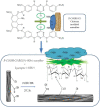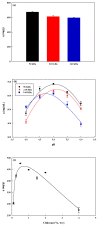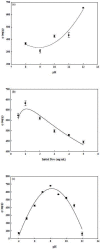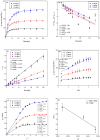Studies of Protein Wastes Adsorption by Chitosan-Modified Nanofibers Decorated with Dye Wastes in Batch and Continuous Flow Processes: Potential Environmental Applications
- PMID: 36005674
- PMCID: PMC9416031
- DOI: 10.3390/membranes12080759
Studies of Protein Wastes Adsorption by Chitosan-Modified Nanofibers Decorated with Dye Wastes in Batch and Continuous Flow Processes: Potential Environmental Applications
Abstract
In this study, reactive green 19 dye from wastewater was immobilized on the functionalized chitosan nanofiber membranes to treat soluble microbial proteins in biological wastewater. Polyacrylonitrile nanofiber membrane (PAN) was prepared by the electrospinning technique. After heat treatment, alkaline hydrolysis, and chemically grafted with chitosan to obtain modified chitosan nanofibers (P-COOH-CS), and finally immobilized with RG19 dye, dyed nanofibers were generated (P-COOH-CS-RG19). The synthesis of P-COOH-CS and P-COOH-CS-RG19 are novel materials for protein adsorption that are not deeply investigated currently, with each of the material functions based on their properties in significantly improving the adsorption efficiency. The nanofiber membrane shows good adsorption capacity and great recycling performance, while the application of chitosan and dye acts as the crosslinker in the nanofiber membrane and consists of various functional groups to enhance the adsorption of protein. The dyed nanofibers were applied for the batch adsorption of soluble protein (i.e., lysozyme), and the process parameters including chitosan's molecular weight, coupling pH, chitosan concentration, dye pH, dye concentration, and lysozyme pH were studied. The results showed that the molecular weight of chitosan was 50 kDa, pH 5, concentration 0.5%, initial concentration of dye at 1 mg/mL dye and pH 12, lysozyme solution at 2 mg/mL at pH 8, and the maximum adsorption capacity was 1293.66 mg/g at a temperature of 318 K. Furthermore, thermodynamic, and kinetic studies suggested that the adsorption behavior of lysozyme followed the Langmuir adsorption isotherm model and the pseudo-second-order kinetic model. The optimal adsorption and desorption conditions based on batch experiments were directly applied to remove lysozyme in a continuous operation. This study demonstrated the potential of dyed nanofibers as an efficient adsorbent to remove approximately 100% of lysozyme from the simulated biological wastewater.
Keywords: chitosan; lysozyme; nanofiber membrane; reactive green 19 dye; removal.
Conflict of interest statement
The authors declare no conflict of interest.
Figures













Similar articles
-
Batch and dynamic adsorption of lysozyme from chicken egg white on dye-affinity nanofiber membranes modified by ethylene diamine and chitosan.Int J Biol Macromol. 2020 Nov 1;162:1711-1724. doi: 10.1016/j.ijbiomac.2020.08.065. Epub 2020 Aug 15. Int J Biol Macromol. 2020. PMID: 32805284
-
Reactive Green 19 dye-ligand immobilized on the aminated nanofiber membranes for efficient adsorption of lysozyme: Process development and optimization in batch and flow systems.Food Chem. 2023 Apr 16;406:135028. doi: 10.1016/j.foodchem.2022.135028. Epub 2022 Nov 24. Food Chem. 2023. PMID: 36446280
-
Antibacterial efficacy of poly(hexamethylene biguanide) immobilized on chitosan/dye-modified nanofiber membranes.Int J Biol Macromol. 2021 Jun 30;181:508-520. doi: 10.1016/j.ijbiomac.2021.03.151. Epub 2021 Mar 26. Int J Biol Macromol. 2021. PMID: 33775766
-
Environmental applications of chitosan and its derivatives.Rev Environ Contam Toxicol. 2015;233:1-43. doi: 10.1007/978-3-319-10479-9_1. Rev Environ Contam Toxicol. 2015. PMID: 25367132 Review.
-
Adsorption of Organic Pollutants from Wastewater Using Chitosan-Based Adsorbents.Polymers (Basel). 2025 Feb 14;17(4):502. doi: 10.3390/polym17040502. Polymers (Basel). 2025. PMID: 40006164 Free PMC article. Review.
Cited by
-
Kiwi Fruits Preservation Using Novel Edible Active Coatings Based on Rich Thymol Halloysite Nanostructures and Chitosan/Polyvinyl Alcohol Gels.Gels. 2022 Dec 13;8(12):823. doi: 10.3390/gels8120823. Gels. 2022. PMID: 36547348 Free PMC article.
-
The Utilization of Chicken Egg White Waste-Modified Nanofiber Membrane for Anionic Dye Removal in Batch and Flow Systems: Comprehensive Investigations into Equilibrium, Kinetics, and Breakthrough Curve.Membranes (Basel). 2024 Jun 3;14(6):128. doi: 10.3390/membranes14060128. Membranes (Basel). 2024. PMID: 38921495 Free PMC article.
-
Breakthrough Curve Modeling and Analysis for Lysozyme Adsorption by Tris(hydroxymethyl)aminomethane Affinity Nanofiber Membrane.Membranes (Basel). 2023 Aug 28;13(9):761. doi: 10.3390/membranes13090761. Membranes (Basel). 2023. PMID: 37755183 Free PMC article.
-
Fabrication and Characterization of Functional Biobased Membranes from Postconsumer Cotton Fabrics and Palm Waste for the Removal of Dyes.Int J Mol Sci. 2023 Mar 23;24(7):6030. doi: 10.3390/ijms24076030. Int J Mol Sci. 2023. PMID: 37047002 Free PMC article.
References
-
- Meléndez-Ortiz H.I., Puente-Urbina B., Mercado-Silva J.A., García-Uriostegui L. Adsorption performance of mesoporous silicas towards a cationic dye. Influence of mesostructure on adsorption capacity. Int. J. Appl. Ceram. Technol. 2019;16:1533–1543. doi: 10.1111/ijac.13179. - DOI
LinkOut - more resources
Full Text Sources

